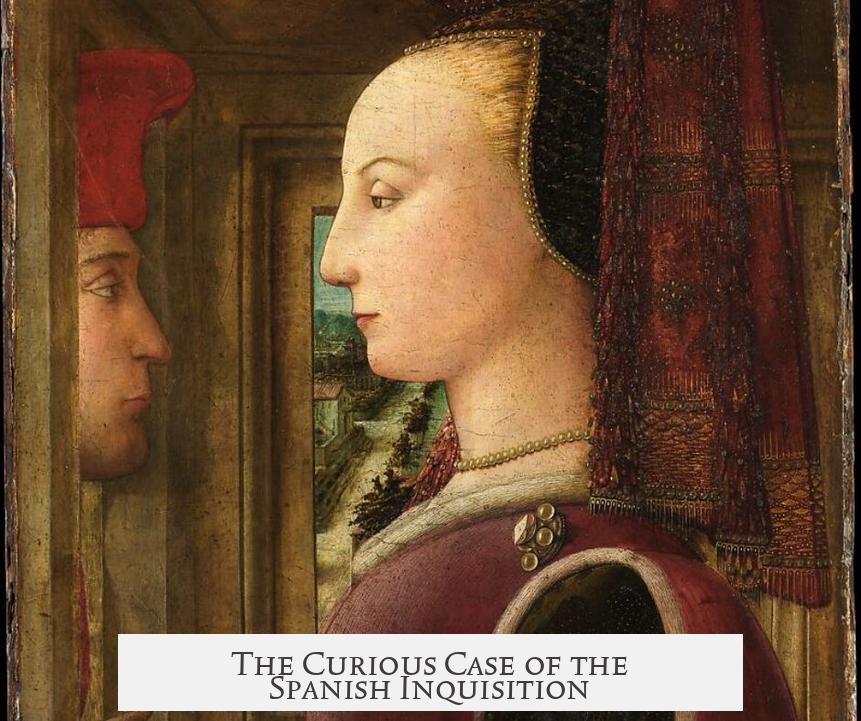A medieval heretic’s fork found by a friend is likely not an authentic medieval artifact. Instead, it probably is a modern reproduction or a misidentified object, possibly from a 19th-century carnival or a decorative ironwork piece.
The item in question appears to be constructed from painted iron. Genuine medieval iron artifacts rarely retain paint without significant degradation, especially after centuries. The paint covering this fork looks fresh, with no significant rust or corrosion. This condition suggests it is less than 100 years old, quite possibly made within the last 70 years. The absence of extensive weathering and rust casts doubt on its medieval origin.
Alternative explanations exist for the object’s identity. It might be an ornamental component from a building, a wagon part, or a plough fragment. Such items often contain rustic or pointed metal elements resembling the supposed heretic’s fork. Given its design and condition, it could also originate from theatrical or carnival torture exhibits common in the 19th century.
Historical context also challenges the artifact’s authenticity. The heretic’s fork is traditionally linked to the Spanish Inquisition as a torture instrument, yet there is no evidence that the Inquisition operated in Southern England. Finding such a device in that region further undermines claims of medieval origin or genuine use. Without reliable provenance—including the artifact’s find spot, soil context, and depth—definitive dating and historical assignment prove difficult.
The heretic’s fork’s supposed function was to prevent victims from lowering their heads, making sleep and speech near impossible. However, critical assessments reveal flaws in this narrative. A person could tilt their head backward to rest, and speech might still be possible despite discomfort. The fork’s size, measured roughly around 13 cm between collarbone and jawbone, might not fit all individuals comfortably, particularly taller individuals or those with longer necks. These practical concerns diminish the fork’s efficacy and historical use reliability.
Experts recommend consulting a Local Finds Liaison Officer (FLO) for further assessment. While identifying and dating the item is valuable, the find does not qualify legally as treasure, so there is no urgent reporting obligation. Many museum professionals, including those working with the Portable Antiquities Scheme, encourage responsible reporting and recording of artifacts to enrich historical databases. This approach fosters a cooperative community rather than suspicion toward finders.
Seeking opinions from niche communities such as a blacksmith forum can also be helpful. Experienced blacksmiths may identify the metal type as wrought iron and suggest origins like old fences or gate components. The fork’s rustic look combined with minor decorative aspects supports this theory.
Publicly criticizing information sources such as Wikipedia can lead to unproductive controversies. The heretic’s fork Wikipedia page has seen recent edits and some disputed claims, reflecting ongoing content debates. Users interested in accuracy are better served by editing articles directly than inciting disputes on social media. Large-scale attention often results in page protection and restricted editing.
In summary, the medieval heretic’s fork your friend found probably is not genuine medieval torture equipment. It looks like a recent reproduction or an unrelated metalwork piece. Authenticity claims need cautious evaluation, contextual evidence, and expert consultation to avoid misleading conclusions.
- The artifact’s painted iron and excellent condition suggest modern manufacture.
- Lack of provenance and find context limits historical interpretation.
- Functionality claims of the heretic’s fork show practical inconsistencies.
- Regional history contradicts the supposed origin of the item.
- Consult local Finds Liaison Officers and specialist forums for identification.
- Use care when relying on or critiquing online sources like Wikipedia.
The Medieval Heretic’s Fork: Myth, Mystery, or Mere Metal? A Friend’s Curious Find

So, a friend stumbles upon what they believe is a “Medieval Heretic’s Fork.” What is it, how authentic is it, and why the fuss? Let’s dig in.
The Heretic’s Fork is a supposed torture device from medieval times. It looks like a double-pronged fork placed between the chin and sternum. The idea is simple: it prevents the person from lowering their head or speaking – thus controlling or torturing heretics through discomfort and silence.
Sounds terrifying. But hold on. Is your friend’s find genuinely medieval? And does this device really work as advertised? Let’s explore.
Authenticity: A Fork in the Road
Your friend’s find looks a little *too* well-preserved for an ancient torture device. Iron tends to rust, especially after several centuries exposed to the elements. Yet this piece sports fresh paint and barely any corrosion. If it were truly a medieval original, it would likely look more like a rusty relic and less like a pair of freshly painted iron prongs.
Experts suggest that this artifact is probably less than 100 years old. More specifically, it’s likely a reproduction crafted in the last 70 years, probably for a museum display, a Halloween prop, or a carnival attraction. Yes, carnivals once had “torture museums” featuring these gruesome objects, where they earned eyeballs but weren’t truly medieval.
Could it even be something else? Perhaps an ornamental piece from an old gate, farm plough, or wagon? The shape and rustic ironwork can easily be mistaken for a torture device by an enthusiastic metal detectorist or amateur historian.
This raises an important question: How often do folks mistake ordinary metal bits for ancient torture gadgets? Quite often, it seems.
The Curious Case of the Spanish Inquisition

Here’s a kicker: the Spanish Inquisition—which supposedly used the Heretic’s Fork—never operated in Southern England. So why would such a device be found there? This mismatch casts further doubt on your friend’s “discovery.”
In truth, provenance—the exact context like location, soil layers, and depth—is crucial. Without this, guessing the artifact’s history is like piecing together a jigsaw with half the pieces missing.
The Heretic’s Fork Functionality: Torture Tool or Tall Tale?
Legend says the fork stopped the victim from lowering their head and speaking. But here’s some food for thought. If the fork stops you from nodding, why not just tilt your head backward? Maybe discomfort gets in the way—but could a victim genuinely never find a comfortable position?
And speaking restricts neck movement, but can you truly *not* talk if you clench your teeth tight? Some experts call this a myth.
Physiologically, the device depends on precise sizing between the collarbone and jaw—a space roughly about 13cm for tall folks. But medieval victims came in all shapes and sizes. The uniformity of the fork seems impractical as a “one-size-fits-all” torture method. Perhaps it was more symbolic than functional.
Seeking Expert Guidance: What To Do If You Find ‘Medieval Relics’

First off: don’t panic or assume instant treasure. Your friend should reach out to their local Finds Liaison Officer (FLO). These professionals assess the age, material, and historical significance of found objects. No rush though—if it’s not treasure by law, there’s no urgent need to report.
The Portable Antiquities Scheme (PAS) encourages hobbyists to document finds. This helps build a broader understanding of history, even if the find is a well-crafted fake or a common old tool.
For your friend’s heretic’s fork, specialized communities can be invaluable. For example, /r/blacksmith on Reddit can analyze whether the iron is wrought, how it might have been made, and if it resembles ironwork from old gates or fences.
Beware of Wikipedia and YouTube Misinformation
The Heretic’s Fork’s Wikipedia page, interestingly, has been a hotspot for editing battles and misinformation. The page was even edited a couple of hours before the latest check, reflecting ongoing confusion and debate.
Quick tip: Avoid announcing “errors” on Wikipedia on social media. Instead, contribute corrections yourself to prevent internet mobs from descending and creating chaos.
YouTube videos often stir the pot, leading to repeated lock-downs of these pages as trolls and enthusiasts flood them with edits. This train of events highlights how our modern information ecosystem can badly distort historical facts.
Is the Medieval Heretic’s Fork Real? Final Verdict
While the medieval Heretic’s Fork *might* have existed, your friend’s find almost certainly isn’t the real deal. It’s either a 19th/20th-century reproduction or a misidentified piece of ironwork. Without solid archaeological context, it’s impossible to label the item medieval or confirm it was a torture device.
Still, the story of this device is fascinating because it reveals how myths and legends intertwine with history. It also reminds us all to check facts carefully.
In the end, does the Heretic’s Fork teach us about medieval torture tactics, or about the dangers of taking mysterious metal bits at face value? Perhaps both.
Next time your friend strikes curious artifacts, remind them: Ask experts, stay skeptical, and enjoy the thrill of discovery without jumping to spooky conclusions.
What is the likely origin of the heretic’s fork found by a friend?
It is probably a reproduction made within the last 70 years. The paint and lack of rust suggest it is not truly medieval.
Could the heretic’s fork actually be a real medieval torture device?
Its function is doubtful. The design would likely cause severe pain, making it hard to sleep or move. However, it might be a decorative or unrelated object.
Why is the finder’s location suspicious for an authentic Spanish Inquisition tool?
The Spanish Inquisition never operated in Southern England. Finding such a device there is unlikely and suggests it is not genuine.
Who can help verify the age and identity of this artifact?
A local Finds Liaison Officer (FLO) can give an age estimate and identification. Participation in the Portable Antiquities Scheme can aid proper recording.
Is the Wikipedia article on the heretic’s fork reliable?
The article is questionable and often edited rapidly. It’s better to consult experts or verified sources rather than rely on Wikipedia alone.




